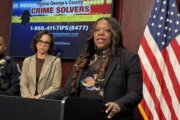Hear our full conversation on my podcast “Beyond the Fame.”
He made the Rock & Roll Hall of Fame as a founding member of Buffalo Springfield.
This Friday, Richie Furay releases his new country music duet album “In the Country.”
“What a challenging, fun project,” Furay told WTOP. “Val Garay, the producer I worked with in 1979, brought up this idea to do an album of country standards and hits. We started putting our lists together because I wasn’t sure how far back he wanted to go, but when the first song on my list was the first song on his list, I knew that we were onto something.”
The album features duets with Vince Gill, John Berry, Jason Scheff and Timothy B. Schmit.
“‘Somebody Like You’ was one of the songs I really wanted to do, Keith Urban is the real deal,” Furay said. “There [are] songs like ‘I Hope You Dance,’ which I just love Lee Ann Womack, that song really touched my heart. … ‘I’m Already There’ [by Lonestar], I’d be driving in my car listening to it, trying to memorize it and I’d just break down crying.”
Born in Ohio in 1944, Furay didn’t necessarily grow up in a musical household.
“Music wasn’t really a big part of my family life, my dad liked to listen to the radio and my mom sang in the church choir, but other than that, it’s just something I wanted,” Furay said. “I asked my parents for a guitar when I was 8 years old for Christmas. … In high school … I was the lead singer for some of the upperclassmen that sang some doo-wop music.”
In 1964, he moved to New York to join the Au Go Go Singers at the Cafe Au Go Go.
“I met Stephen Stills and we put a little group together,” Furay said. “When that broke up, he moved to California. … A friend of mine [Gram Parsons] brought The Byrds’ first album up for me listen to. … I said, ‘I gotta get ahold of Stephen and find out what he’s doing. … He said, ‘Come on out to California, I’ve got a group, all I need is another singer.'”
That group became Buffalo Springfield with Neil Young, Bruce Palmer and Dewey Martin.
“When I got out there, Stephen and I were the band, there was no band, it was just me and him,” Furay said. “It all worked out for the better because Stephen and I sat together in a little apartment and we learned all of the songs that he wrote for the first ‘Buffalo Springfield’ record. … A couple weeks into that we met Neil Young and Bruce Palmer.”
Their band name came from a steamroller labeled Buffalo-Springfield Roller Company.
“There was a steamroller working on Fountain Avenue in Los Angeles very close to where we were staying at the time,” Furay said. “We vandalized the steamroller, took some signs off it, put it on a fireplace mantle in one of our friends’ houses and went, ‘Hey, that looks like a good name!’ Little did I know the Springfield was nine miles from my town in Ohio.”
Their self-titled debut album “Buffalo Springfield” (1966) included “For What It’s Worth.”
“[The album] didn’t quite gain the momentum or have the success everyone was looking for, so [Atlantic Records President Ahmet Ertegun] was out in California to hear songs we would put on the second album. After Stephen, Neil and I played some songs, we’re packing up our instruments and Stephen said, ‘I’ve got one more for what it’s worth.”
Ironically, the title isn’t actually in the song, but it became an iconic peace anthem.
“We came out of folk music, which had a lot of protest music,” Furay said. “When I heard the song, it went over my head. I was into … rocking at the Whisky a Go Go and here’s this little, ‘There’s something happening here.’ Ahmet said, ‘That’s a hit. We have to record that song.’ … I think most of that first album was done on four-track recording.”
Their second album, “Buffalo Springfield Again” (1967), featured “Bluebird” and “Mr. Soul.”
“‘Bluebird’ is obviously about a relationship, ‘Mr. Soul’ was Neil’s vision of being a rock ‘n roll star,” Furay said. “As you look at the other songs on the album like ‘Expecting to Fly,’ we were listening to The Beatles and heard what they were doing and wanted to join in that little crowd of experimentation if we could. … We weren’t being pigeon-holed.”
Their final album, “Last Time Around” (1968), closed with the Furay-penned “Kind Woman.”
“Leave it to me to break that band up!” Furay said. “At the Whiskey A Go Go, there was this lady who came and stood right in the front. She came with her boyfriend. … We were there for six weeks, she would be right there in the front row. Even without my glasses on, she caught my attention. I wrote that song about her and today we’re 55 years together.”
When Buffalo Springfield broke up, Furay and bandmate Jim Messina broke off to form Poco alongside Timothy B. Schmit, Rusty Young, George Grantham and Randy Meisner.
“Jimmy and I saw the writing on the wall,” Furay said. “My feeling was as long as Stephen was in the band, I was in the band. When I look at Buffalo Springfield, it was Stephen’s band, he was the heart and soul. … When Stephen left, Jimmy and I decided we were going to follow on with our vision of hopefully crossing over with this country-rock music.”
Poco would go on to release 19 studio albums, from its debut release, “Picking Up to Pieces” (1968), to its most famous, “Legend” (1978), featuring the hit “Crazy Love.”
“‘Picking Up the Pieces’ … kind of tells the story: ‘Hey you guys, I’m really just a lot like you,’ speaking to the country market,” Furay said. “We followed through with that vision and started a genre that became some of the most significant American rock ‘n roll music with The Eagles. Glenn Frey used to sit on my living-room floor when I was rehearsing.”
In 1997, Buffalo Springfield was inducted into the Rock & Roll Hall of Fame.
“People would recognize you and your peers would acknowledge your contribution to music,” Furay said. “It was very humbling and it’s really a great honor to be holding onto.”
Does he stay in touch with Stills, Young and the rest of Buffalo Springfield?
“We’re getting together actually in three weeks to do an interview for a documentary that my manager is putting together with me,” Furay said. “Cameron Crowe is going to be doing the interviews, so we’re going to see each other in a couple of weeks.”
Hear our full conversation on my podcast “Beyond the Fame.”








